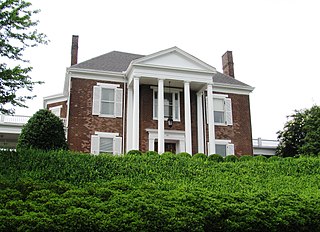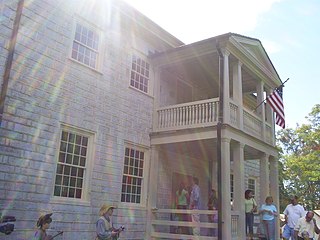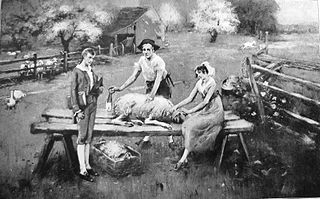

Chisholm Tavern was a historic building at Front and Gay streets in Knoxville, Tennessee. It stood on the same block as William Blount Mansion. Construction was completed cn. 1792, and it remained for almost 200 years until it was demolished as a part of urban renewal in 1966. A historic marker was placed at its location (35° 57.691′ N, 83° 54.863′ W) by the Blount Park Association in 1967.

Gay Street is a street in Knoxville, Tennessee, United States, that traverses the heart of the city's downtown area. Since its development in the 1790s, Gay Street has served as the city's principal financial and commercial thoroughfare, and has played a primary role in the city's historical and cultural development. The street contains Knoxville's largest office buildings and oldest commercial structures. Several buildings on Gay Street have been listed on the National Register of Historic Places.

Knoxville is a city in the U.S. state of Tennessee, and the county seat of Knox County. The city had an estimated population of 186,239 in 2016 and a population of 178,874 as of the 2010 census, making it the state's third largest city after Nashville and Memphis. Knoxville is the principal city of the Knoxville Metropolitan Statistical Area, which, in 2016, was 868,546, up 0.9 percent, or 7,377 people, from to 2015. The KMSA is, in turn, the central component of the Knoxville-Sevierville-La Follette Combined Statistical Area, which, in 2013, had a population of 1,096,961.

The Blount Mansion, also known as William Blount Mansion, located at 200 West Hill Avenue in downtown Knoxville, Tennessee, was the home of the only territorial governor of the Southwest Territory, William Blount (1749–1800). Blount, also a signer of the United States Constitution and a U.S. Senator from Tennessee, lived on the property with his family and ten African-American slaves. The mansion served as the de facto capitol of the Southwest Territory. In 1796, much of the Tennessee Constitution was drafted in Governor Blount's office at the mansion. Tennessee state historian John Trotwood Moore once called Blount Mansion "the most important historical spot in Tennessee."
Contents
Chisholm Tavern was originally constructed as a home for Captain John D. Chisholm, who came to Knoxville (then known as James White’s Fort) with Governor William Blount in 1790. Captain Chisholm purchased a half-acre lot on Front Street, and is believed to have used the same architect who designed the Blount Mansion. Both homes utilized frame construction with similar detailing. The home became the frontier community’s first tavern, which in that era included both hotel and dining facilities. It eventually declined until, by the time of the Great Depression, the Historic American Buildings Survey documented it as being occupied by "slum tenants."

The Great Depression was a severe worldwide economic depression that took place mostly during the 1930s, beginning in the United States. The timing of the Great Depression varied across nations; in most countries it started in 1929 and lasted until the late-1930s. It was the longest, deepest, and most widespread depression of the 20th century. In the 21st century, the Great Depression is commonly used as an example of how intensely the world's economy can decline.
The federal survey notes the following: The two story frame house was built on a steep slope. At each end and on the kitchen ell are brick chimneys of the freestanding variety. The interior is typically of the Revolutionary Period: sunburst mantel in the dining room, cupboards with scrolled shelves in the dining room, and dog-eared trim throughout the house. The triangular space beneath the main stairs is paneled with radiating rails.
Before Chisholm Tavern was demolished, there were discussions as to whether the Tennessee State Legislature may have met there when Knoxville was the state capital. During the formative years, the legislature is believed to have met at multiple convenient locations in the city, but no conclusive evidence had survived that they had met in this tavern.


















